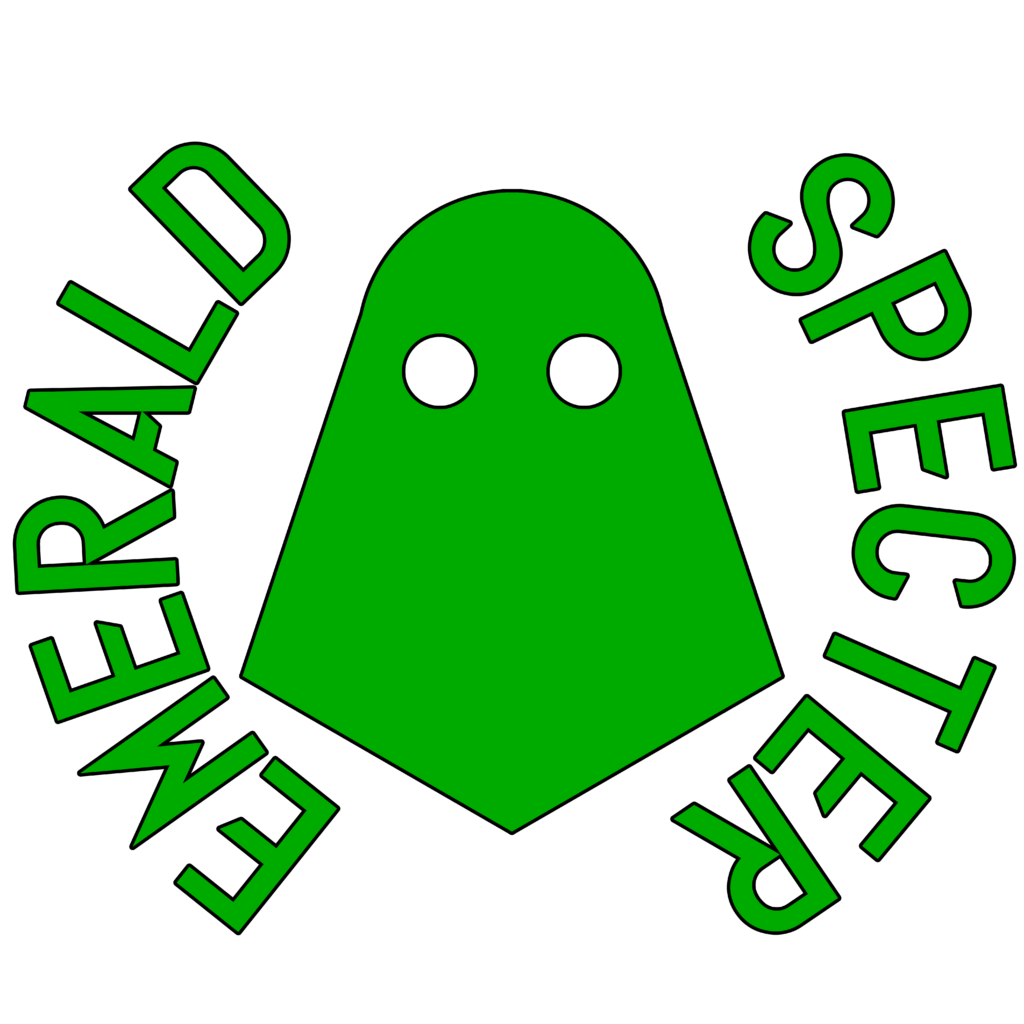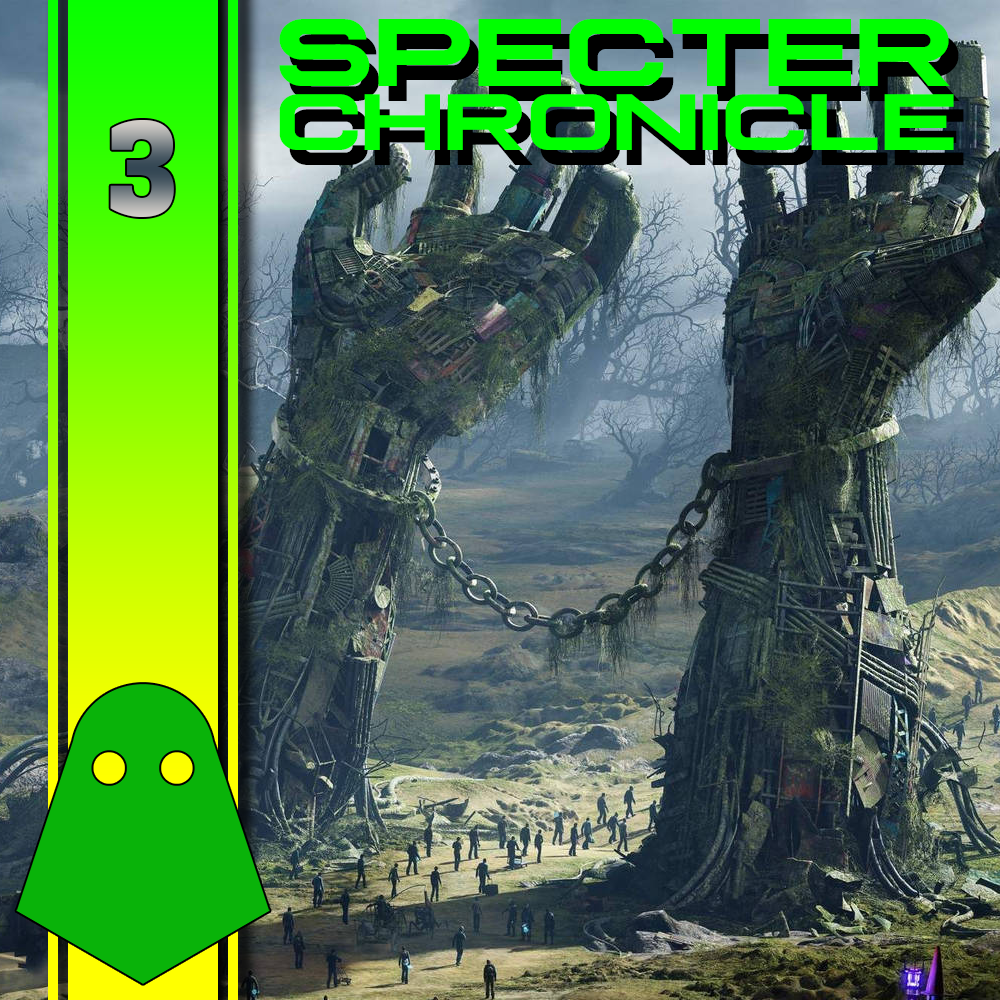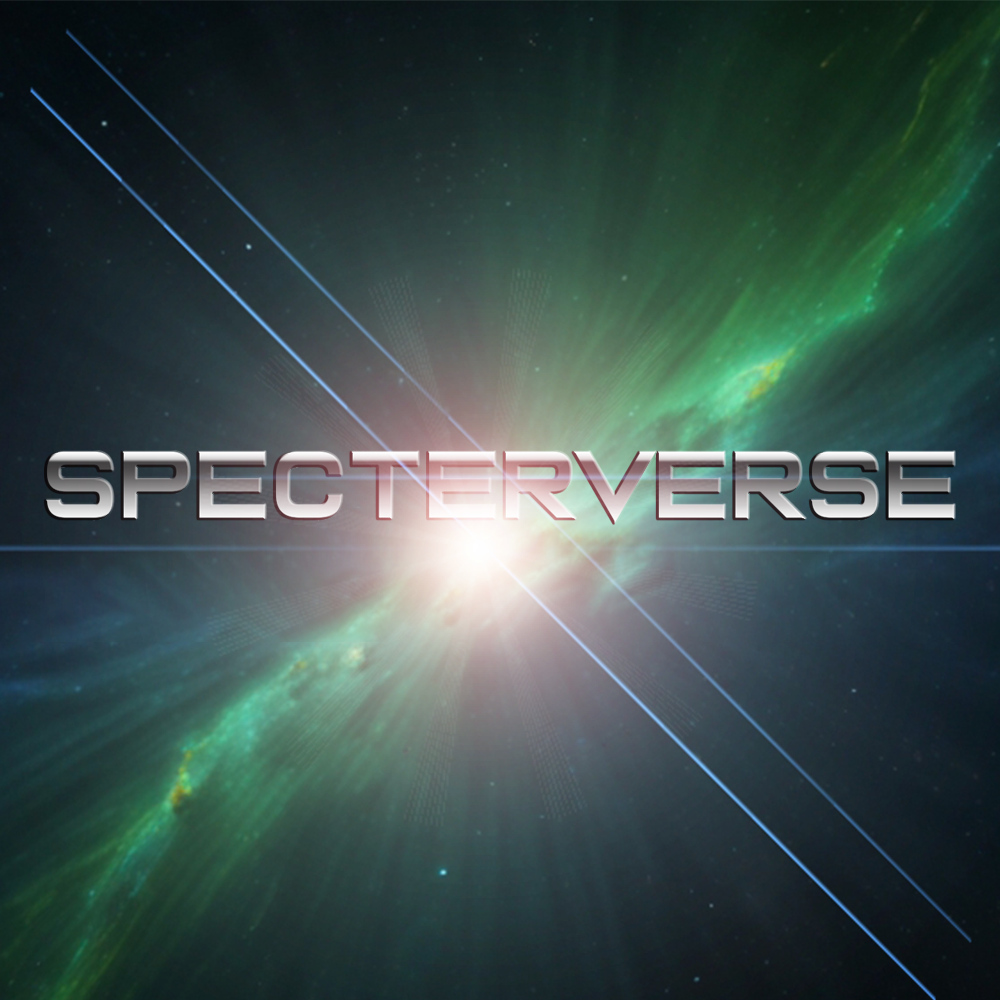I have slowly been building a connected universe of stories for the better part of 35 years and I have finally reached the point that I can start putting out actual information about one facet of this connected universe. Since I’ve got this website and a fancy column I write, I figured I’d just write about it here… so here it is, a column about my worldbuilding (as well as worldbuilding in general).
Let’s go!
I should start by saying that all my stories or backgrounds for stories didn’t start out connected. When I started out creating my own shared comic book universe (which is not the universe we’re discussing here), I intended it as a stand alone thing. That goes for my Doctor Who pastiche (also not what we’re discussing). There were a couple of other things that also got created on their own and I had no intention of them joining anything, either.
But an epiphany happened one day.
I stepped back and looked at all my half written first drafts, scanned all the outlines, looked through all the character arcs, and finally took a broader look at all the directions the characters in each “universe” was heading. Did everything line up perfectly? Absolutely not, but there was something there.
The pastiche was the glue because it has an oddity built in that can be connective tissue for everything else. Using that as the starting point, I grabbed the comic universe and weaved part of that into the pastiche… and came up with a hell of a killer “end point” to build towards. That point worked for the universe we’re going to talk about today, too, as well as a few other items.
And that is how it all started.
The world I’m going to discuss today has roughly 20,000,000 years of history to it. While I would limit the “recorded” history to only about 14,000 years (the “end point” mentioned above is the stopping point), the world does have a whole lot more going on. If one were to compare it to another planet, say Earth, obviously things went on before recorded history here, too.
Now, I can keep being obtuse and continue calling it “the world,” but I’d rather make it simpler and tell you what the name is: Dhumin. If you’re wondering, yes, Dhumin is a Cthulhu Mythos Great Old One. The residents of this world named their world after this very deity, on purpose, and they do have a means of reference for it that will eventually be revealed through story. In fact, their entire solar system is named after Cthulhu Mythos entities, as that is their cosmological exposure at the time of their astronomical discoveries.
Hopefully, I have a few people excited about the story aspect, at least. I intend to do a “History of Dhumin” podcast at some point, not quite as in depth as Dan Carlin’s Hardcore History, but more than just a rattling off of names and dates.
Being an amateur worldbuilder, I wanted to make something that was wholly my own, but I also wanted the world to look somewhat realistic. This meant that I couldn’t just hand draw a map (although that only came after four or five attempts) nor could I just take and modify another map (much like George RR Martin did for the Game of Thrones Westeros continent). So, I decided to come up with a different idea all together.
I found a plethora of different “landform” shapes that I thought would look good as continents and islands (that would also fit into some of the key events in history) and saved them to my computer. Each one was then sized to however large I needed it, silhouetted, and added to a much larger map of the entire surface of Dhumin. Once everything was positioned correctly, I overlayed a temperature zone layer and toyed with it until I knew which areas would be icy and which ones would be tropical. All I needed then was the actual interiors of the continents.
Before I get too far, why don’t I show you the world map of Dhumin, complete with temperature zones.
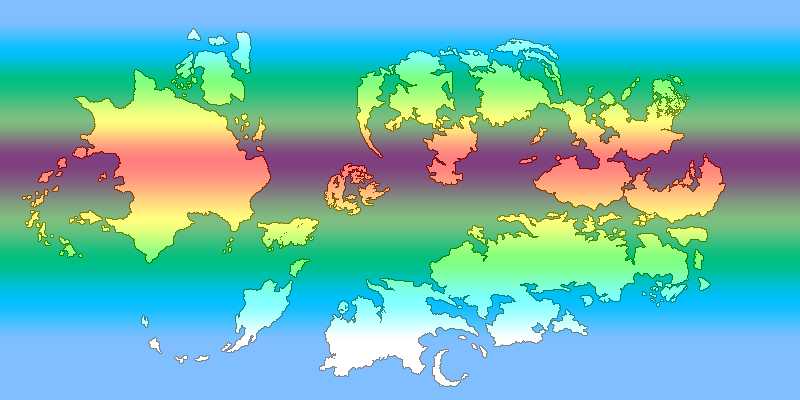
The warmer the color (red, orange, etc) the warmer the climate, the cooler the temperature the cooler the climate. Continents are a bit debatable in this case, though, as I haven’t really declared any in particular. So, I should do it right here during this column, how about that?
Starting in the west is definitely a continent (one), moving east in the north to the three island archipelago arrangement with the center one that looks kind of like a horse rearing up should be a collective second continent (two), the landmass right next to them is likely its own continent (three), connected via land bridge to the “bird shaped landmass hovering over two nests” continent group (four), then we have the long continent (five), just to the west the one with the obvious crater just to the south of it (six), and finally the big island to the west with the trail of islands going west is the last one (seven).
These continents have not, as yet, been named because I am preparing to go through and get more detailed into the history of this world. Part of that history is writing some of it as that history is “happening,” meaning names of things will be given as those things are “discovered.”
I have a rough understanding of what the whole history of the world is, I just haven’t gotten more detailed into that history. This is where the podcast and writing a deeper outline so that books can be written. Ideally, a full cast audio drama series would be great to flesh out some eras of the history but small steps.
I’ve gone off on a weird tangent and should get back to the topic at hand: worldbuilding.
With such a long history (as mentioned above, either 20 million or 14 thousand years of it), there are a lot of eras available to delve into… but all history starts at the beginning. Since this is a fictional location, one might describe this particular era as a “fantasy” era.
Demographics
One of the easiest thing to do in the case of most fantasy worlds is to base the majority of the sentient life on humans (humans, dwarves, elves, gnomes, etc). I mean that each species is basically a slight derivation on humans (taller, shorter, pointed ears, etc) and there are plenty of fantasy works in the world that cover these areas in abundance.
Since Dhumin’s inception, however, I have made a conscious effort to deviate from the “fantasy norms” and also come up with a reason to have these different species on Dhumin (scientifically speaking). I won’t elaborate on the scientific background of the reasons on why species of Dhumin exist but know that there is definitely a reason.
I did begin with humans, the basis for something to latch on to, as something “familiar” for the reason or consumer of the information. Humans are no greater in number or lesser in number than the other species who inhabit Dhumin, but they are in just as wide a variety as one is used to here on Earth. They are only one seventh of the inhabitants.
Along with them are a species who have bioluminescent skin called Lumyen (loo-me-en). Lumyen do resemble humans in appearance, except for their glowing skin and colored hair. Biologically, Lumyen women are the dominant sex as they range in size from 6’9″ to 7’11” tall, and they are far more muscular than their male counterparts. Male Lumyen are 5’0″ to 6’2″ tall and socially the ones responsible for childrearing. This species originated in subterranean locales and is largely considered responsible for the bioluminescent skin.
The third species are called the Pranthos, a pseudo-bipedal feline species. Pranthos can be both bipeds and quadrupeds depending on their needs. The fur of the species tends to be dominated by stripes but can also resemble maned felines or spotted as well. Both males and females share the duties of the species and seem to largely be ambivalent when it comes to social norms.
Next in line are the Drokahn, a species who do resemble humans in figure only. All Drokahn are genderless but resemble the males of the human species. Drokahn skin is a pitch black, their eyes are solid white, their mouths are also solid white (to include their blood), and they have no nose. They have natural night sight, though they can also see in regular light just fine, and each have the ability to reproduce twice in their lifetime.
A familiar-esq entry to the list of species are the Hardravin, basically dragons. The Hardravin come in a variety of shapes and sizes, though believing that they will reach the sizes depicted in popular media (like the dragons in House of the Dragon, specifically). Hardravin are larger than most of the other species on Dhumin but they are mostly not gargantuan in size and more-so resemble Eastern style dragons… though the Western style ones do exist in a smaller capacity. These are the most long lived species on the planet, with an average lifespan ranging about 350 years or so.
All of the species listed above are made up the same basic building blocks of life: skeletons, musculature, blood, nervous systems (that are recognizable), and so on. Yes, that means we deviate from that with the final two “indigenous species” on Dhumin significantly enough to be unique.
First of the final two are the Vodan, a bipedal species who are vegetation based. The Vodan have a watery sap for “blood,” vines and greenery for “organs,” and a wooden bark for what would pass for “skin.” There is really no “norm” for a typical Vodan, they come in different shapes and sizes as well as a variety of “colors.” While the Hardravin are the longest lived on average, Vodan have been known to live well past even the oldest Hardravin. This would be largely due to carefully avoiding combat and taking care of oneself to the best of their ability.
Finally, we have the Kryskuul, the silicone based species on Dhumin. Bipedal and crystalline coated, the Kryskuul have essentially a biologically built in armor due to the crystals. There are a number of things that make the Kryskuul different than the other species on Dhumin, like the lack of a “blood” inside and the fact they regrow their damaged pieces slowly over time (crystal formation). While higher temperature areas are where the Kryskuul thrive, they are able to survive in colder environments in extreme circumstances.
That rounds out the seven sentient species that inhabit Dhumin. There are other species that are on the planet, too, such as the animals and plants that live on the planet. I won’t be getting much into those in this world during this column but they do exist… but I will hint that there is another sentient species on this planet, though they aren’t indigenous to Dhumin.
Surface Features of the World
The map I posted above is just the continental (and island) outlines of the world, along with the temperature zones. There is a lot more detail going on in my map than just that, I didn’t want to just go right into the full reveal right off the top, though. Here’s what the world looks like through a “satellite view:”
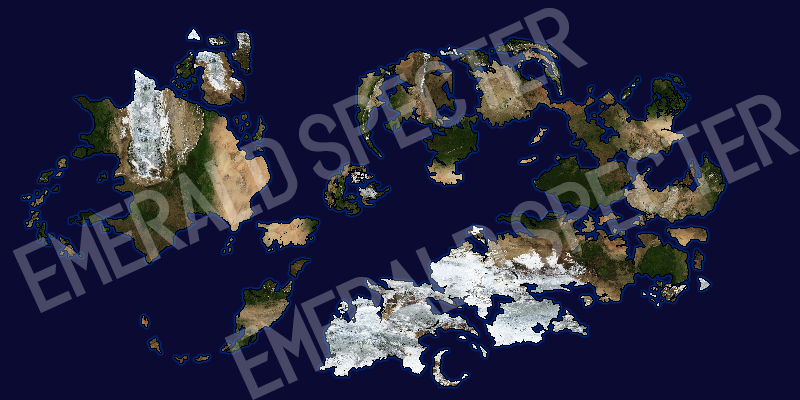
Yes, I watermarked it. Sorry, but there are a few more things that will be going on in this map and it’ll be getting bigger for the official release of the information coming later. Let’s not concentrate on that part.
The map contains mountains, deserts, rainforests, tundra, and other kinds of landforms that are clearly visible… from space. The aforementioned first continent has a mountain range so large that it has a permanent snow covering hundreds of miles across (and yes, the mountains in that range are HUGE). All of this world has things going on and there are mysteries to the species that I described above because, you guessed it, in 20 million years things have happened before recorded history.
In Conclusion
Yeah, it feels like I just got started. There is also a lot more to the whole “worldbuilding” thing in general. I alluded to a lot of stuff that I have worked out and you should also have those things at least outlined so you can build your own world.
I also hope that I hooked you with the world that I’ve built here and you’ll come check out the stories that will be told involving the characters from this world. Dhumin will have initially stories revolving somewhere near the “beginning of recorded history” (the fantasy era) and will eventually have tales (or a series of tales) come from the space age (or the future era). Fantasy to science fiction is quiet a range and there is a whole range of things that go on in between.
Thanks for reading.
